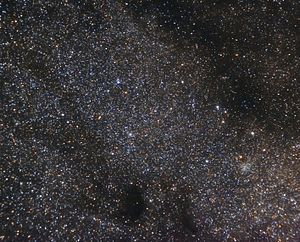Messier 24
| Milky Way section (or sky section with little interstellar dust) |
|
|---|---|
| Sagittarius Cloud / Delle Caustiche / Messier 24 | |

|
|
| Image with a section of the Sagittarius cloud; The open star cluster NGC 6603 can be seen at the bottom right, the two dark clouds B 92 (left) and B 93 (right) in the lower center. | |
| Constellation | Sagittarius |
|
Position equinox : J2000.0 |
|
| Right ascension | 18h 16m 48s |
| declination | −18 ° 33 ′ 00 ″ |
| Further data | |
| Angular expansion |
approx. 2 ° × 1 ° |
| distance |
approx. 10,000 - 15,000 ly |
| diameter | ~ 300 ly |
| history | |
| discovery | |
| Date of discovery |
June 20, 1764 |
| Catalog names | |
| M 24 • IC 4715 • Cr 374 | |
| Aladin previewer | |
Messier 24 is a visible part of the Sagittarius arm of the Milky Way . Angelo Secchi (Vatican Observatory ) coined the name Delle Caustiche around 1850 based on the appearance of the star cloud . Today it is mostly called the Sagittarius Cloud or the Small Sagittarius Cloud - to distinguish it from the large Sagittarius Cloud , a visible part of the central area of the galaxy a little further south. Charles Messier considered the very compact cloud in 1764 to be a star cluster and therefore included it in his nebula catalog .
While the central and all distant parts of the Milky Way are covered by interstellar dust and thus invisible to the human eye, a window in the dust distribution allows a view of a section near the galactic center . The dust here normally swallows 20–30 brightness levels of light. In this sense, the Messier 24 object can also be understood as a region of the sky with little absorption or interstellar dust.
The area lies in the constellation Sagittarius and has an apparent extension of around 2 ° × 1 °. The star cloud is about 10,000 light years away. It contains several open star clusters, NGC 6603 in particular stands out. Furthermore, the two dark clouds Barnard 92 and Barnard 93 stand out clearly against the background of the Sagittarius cloud.
The object was observed by Charles Messier in 1764 and was added to his catalog under number 24 . Sometimes Messier 24 is also identified with NGC 6603 ; however, based on his description of the object (especially its dimensions), there is no doubt that Messier observed and described the star cloud and not just this star cluster.
Around 1915, Edward Barnard was able to photograph two dark nebulae that form the northern edge of the "viewing tube": Barnard 92 (also called black hole ) and Barnard 93 . They are much larger than the "flakes" of interstellar dust, which are usually around 25 light years in size.
Web links
- HTT Skyguide (description and maps for Messier 24).
- Amateur recordings Spektrum.de
Individual evidence
- ↑ SIMBAD query
- ↑ a b Messier 24 at SEDS.
- ↑ A.Unsöld: The new cosmos (§ 11.3); 7th edition, Springer-Verlag 2005.
-
↑ Charles Messier's Original Catalog of 1771 seds.org
Scan of the catalog entry ( Memento from December 30, 2010 in the Internet Archive ) - ^ Photos by Barnard 92 and 93 in SEDS.

